![[Illustration]](https://oldbook.b-cdn.net/kitaplar/2/pg10115-h/images/cover.jpg)
TWO CENTURIES OF COSTUME IN AMERICA
MDCXX-MDCCCXX
ALICE MORSE EARLE
AUTHOR OF “SUN-DIALS AND ROSES OF YESTERDAY” “OLD TIME GARDENS,” ETC.
VOLUME I
Nineteen Hundred and Three
To George P. Brett
“An honest Stationer (or Publisher) is he, that exercizeth his Mystery(whether it be in printing, bynding or selling of Bookes) with more respect tothe glory of God & the publike aduantage than to his owne Commodity &is both an ornament & a profitable member in a ciuill Commonwealth.... Ifhe be a Printer he makes conscience to exemplefy his Coppy fayrely & truly.If he be a Booke-bynder, he is no meere Bookeseller (that is) one who sellethmeerely ynck & paper bundled up together for his owne aduantage only: buthe is a Chapman of Arts, of wisdome, & of much experience for a littlemoney.... The reputation of Schollers is as deare unto him as his owne: For, heacknowledgeth that from them his Mystery had both begining and means ofcontinuance. He heartely loues & seekes the Prosperity of his owneCorporation: Yet he would not iniure the Uniuersityes to advantage it. In aword, he is such a man that the State ought to cherish him; Schollers to louehim; good Customers to frequent his shopp; and the whole Company of Stationersto pray for him.”
—GEORGE WITHER, 1625.
CONTENTS
VOL. I
I. APPAREL OF THE PURITAN AND PILGRIM FATHERS
II. DRESS OF THE NEW ENGLAND MOTHERS
III. ATTIRE OF VIRGINIA DAMES AND THEIR NEIGHBORS
IV. A VAIN PURITAN GRANDMOTHER
V. THE EVOLUTION OF COATS AND WAISTCOATS
VII. CAPS AND BEAVERS IN COLONIAL DAYS
X. THE DRESS OF OLD-TIME CHILDREN
XIII. PATTENS, CLOGS, AND GOLOE-SHOES
XIV. BATTS AND BROAGS, BOOTS AND SHOES
LIST OF ILLUSTRATIONS IN VOLUME I
Frontispiece
This fine presentation of the dress of a gentlewoman and infant child, in themiddle of the seventeenth century, hung in old Plymouth homes in the Thomas andStevenson families till it came by inheritance to the present owner, Mrs.Greely Stevenson Curtis of Boston, Mass. The artist is unknown.
...
